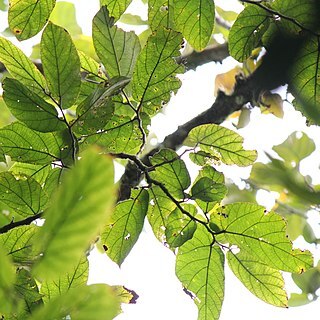Shrub or tree up to 8 m tall. Branchlets drying brown. Leafy twigs 2-4 mm thick, whitish to yellowish hirtellous to puberulous to subhispidulous, smooth to scabridulous; internodes solid. Leaves distichous; lamina oblong to elliptic to subovate, (5-)10-25 (-33) by 4-11(-15) cm, strongly asymmetric, subcoriaceous to chartaceous, apex acuminate, base strongly inequilateral, at the broad side cordate with the lobe often covering the petiole, at the narrow side cordate to cuneate, margin irregularly dent(icul)ate; upper surface hispidulous to strigillose, ± scabrous, lower surface whitish to yellowish puberulous to subhispidulous to strigillose on the veins, smooth to scabridulous; cystoliths on both sides; lateral veins (5-)6-8 pairs, the basal pair up to 1/3-1/2 the length of the lamina, (at least) at the broad side branched, often also some other lateral veins branched or furcate, tertiary venation (laxly) scalariform; waxy glands in the axils of both basal lateral veins, and at the broad side of the lamina also in the axil of the lateral vein below the main basal one, moreover, smaller ones in the axils of other lateral veins; petiole 0.5-1.5 cm long, slightly different to almost equal in length on the same twig, puberulous to hirtellous, the epidermis persistent; stipules semi-amplexicaul, 0.7-1 cm long, whitish (minutely) puberulous on the keel and ciliolate or subglabrous, caducous (or subpersistent). Figs axillary, mostly solitary, ramiflorous on short spurs, or cauliflorous, on clusters of up to 1 cm long leafless branches with short internodes; peduncle 0.2-1.3 cm long; peduncular bracts 3, scattered, 2 subopposite, or 3 verticillate, 1.5-3 mm long, appressed-puberulous outside; receptacle subglobose, 1-1.8 cm diam. when dry, densely whitish to yellowish puberulous to subvelutinous, smooth, without lateral bracts, yellow to red at maturity, apex convex, ostiole c. 4 mm diam., surrounded by a rosette of apical bracts; internal hairs abundant. Tepals red, glabrous. Styles glabrous.
More
A fig. It is a medium sized tree or shrub. The smaller branches are long and usually hang down. The leaves have a sweet smell while drying and end with a blunt point. They are heart shaped at the base and the lobes are very unequal in size and shape. The edges of the leaves can be entire or toothed. The fruit are in the axils of leaves and mostly produced singly although sometimes in pairs.


